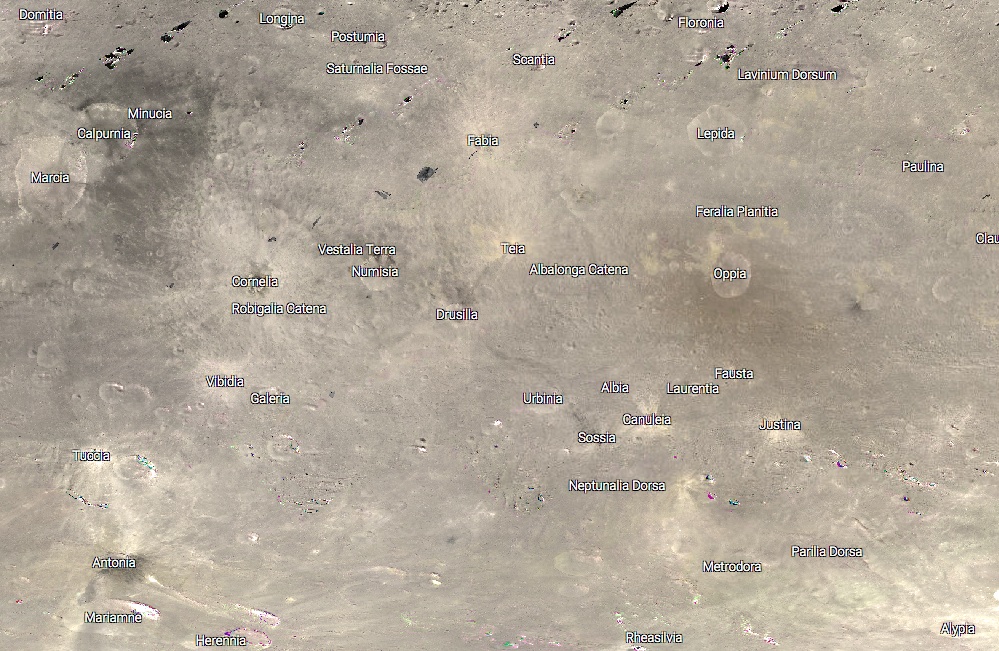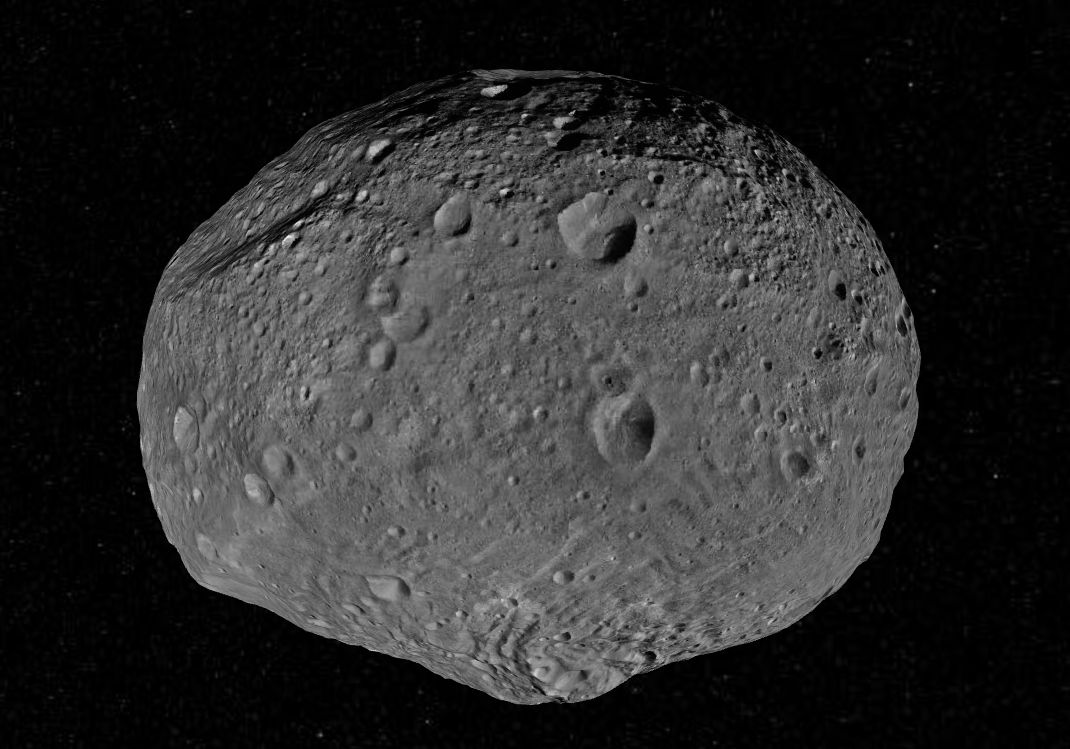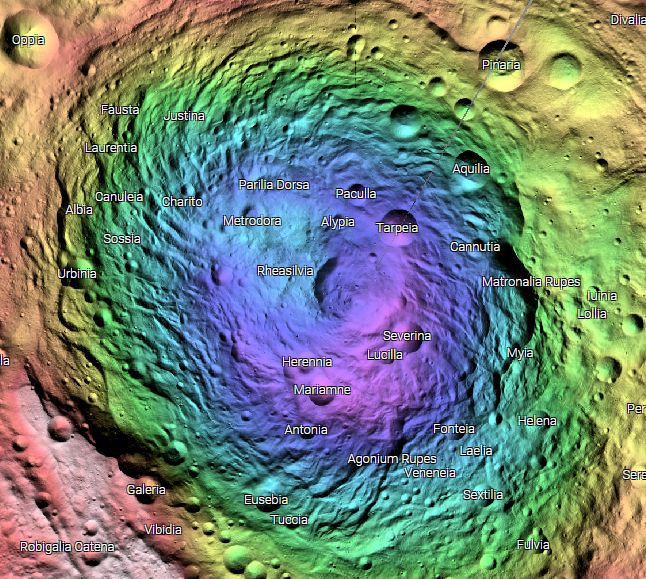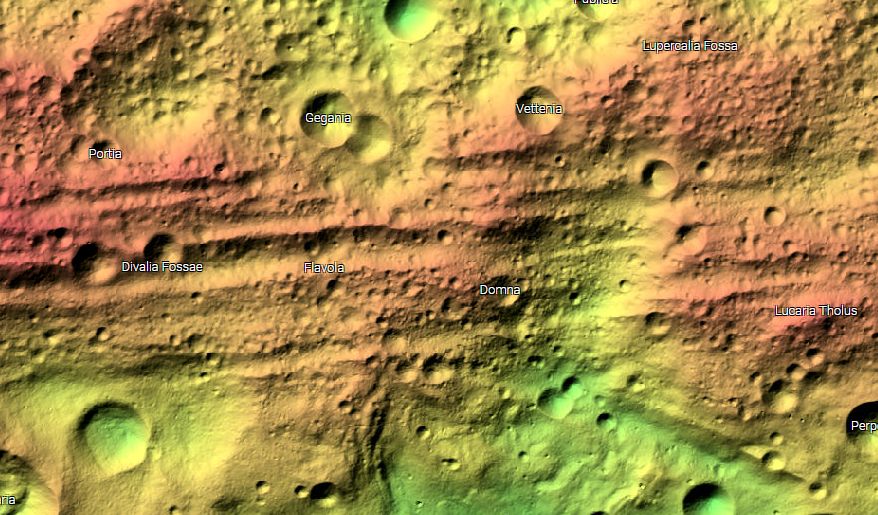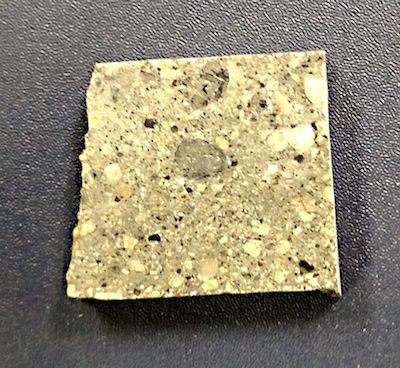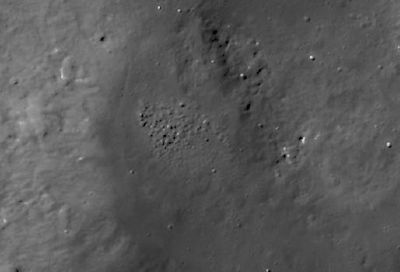Quick Facts About Vesta
Vesta at a Glance
Vesta is the second most massive object in the asteroid belt (after Ceres) with a mass of 2.59 x 1020 kg. However, in terms of size, it ranks as number three in the asteroid belt (after Ceres and Pallas), with a mean diameter of 525 km. Seen from Earth, Vesta is the brightest of the asteroids; at its brightest it can just barely be seen with the unaided eye from a dark location. Vesta was discovered by Heinrich Wilhelm Olbers on March 29, 1807.
Vesta the Planetesimal
Measurements of Vesta’s density indicate that, unlike many other asteroids, Vesta is not just a big chunk of rock. Instead, like the larger terrestrial planets (Mercury, Venus, Earth, and Mars), Vesta is differentiated. It has a crust featuring solidified basaltic lava, a rocky mantle, and a nickel-iron core. Scientists theorize that, early in the history of the solar system, many small differentiated worlds such as Vesta, known as planetesilmals, were the building blocks for the terrestrial planets. Vesta may be a leftover from this process.
The Shades of Vesta
Take a look at Vesta’s surface using the True Color layer of Vesta Trek. You’ll see a generally very light surface and areas of noticeably darker smudges.That light surface is quite interesting. On the Moon, space weathering darkens exposed soil as tiny meteorites and energetic particles produce a dark coating of metal nanoparticles. Similar space weathering has been seen on several asteroids as well. But Brown University planetary Scientist Carle Pieters has found that exposed surfaces on Vesta do not build up a coating of metal nanoparticles. Why not? That remains one of Vesta’s mysteries. Now how about those dark smudges? Tom McCord of the Bear Fight Institute analyzed the spectrum of these dark areas and found evidence that this dark material could be debris from carbonaceous chondrites that have hit the surface of Vesta. Carbonaceous chondrites are dark-colored, primitive asteroids and meteoroids that retain much of the original composition of the cloud of dust and gas that formed the solar system. Fascinatingly, a number of these objects even contain amino acids and nucleotides, the building blocks of life! Because of Vesta’s relatively low surface gravity, some of these carbonaceous chondrites apparently hit with low enough velocities to keep their dark material from being vaporized by impact. Instead, we see blankets of dark carbonaceous material on the areas of Vesta’s surface surrounding these impact sites.
Now, take a look at the Hydrogen layer in Vesta Trek. It shows hydrated minerals distributed across Vesta’s surface. Where does this hydrogen come from? According to the Planetary Science Institute’s Thomas Prettyman, lead scientist for Dawn’s gamma ray and neutron detector (GRaND), those same carbonaceous chondrites may provide the answer. Carbonaceous chondrites can have high concentrations of hydrogen-rich volatiles including water.
The Battered South Pole
Take a look at Vesta in the 3D view of Vesta Trek. Vesta is large enough to have achieved hydrostatic equilibrium as it formed. That means that it should have a nice, spherical shape. But the 3D view of Vesta shows it to be far from spherical. It almost looks like a good portion of the southern portion of Vesta is missing. That’s because that is exactly what has happened!
Approximately 1 billion years ago, an asteroid slammed into Vesta’s South Pole. The impact was almost fatal for Vesta, leaving a crater called Rheasilvia that is about 500 km across (keep in mind that Vesta itself is only 525 km across). Rheasilvia is 19 km deep, so this giant impact excavated material from deep beneath Vesta’s surface. As is the case with many large craters, Rheasilvia has a peak of uplifted material in its center. Rheasilvia’s central peak is a very impressive mountain, rising 23 km above the low spot on the crater floor. To put this into perspective, Mt. Everest, the highest spot on Earth, rises only 8.8 km above sea level. To get a good view of Rheasilvia, use Vesta Trek's South Polar projection and select the Color Hillshade layer.
The Rheasilvia impact wasn’t the only major cataclysm to strike this area of Vesta. Another, older giant impact created Veneneia crater, some 400 km in diameter. The younger Rheasilvia crater overlaps and has obliterated much of Veneneia, but you can still see a portion of Veneneia sticking out from Rheasilvia. Again, use Vesta Trek's South Polar projection and Color Hillshade layer for your best view.
Vesta’s Grooves
A parallel set of large grooves encircles Vesta along its equatorial region. At up to 20 km across and 465 km long, Divalia Fossa is comparable to Earth’s Grand Canyon (446 km long and 29 km wide). But Divalia is just one of a series of similar features arranged in parallel along the equator. Explore them by using Vesta Trek’s search function to take you to Divalia Fossae.
What caused these giant chasms? An important clue comes from noticing that they are concentric to Rheasilvia crater. These seem to be fractures caused by the impact that formed Rheasilvia. A team led by Debra Buczkowski of the Applied Physics Laboratory, took a closer look at these features and noted that they are not actually cracks, but features known as fault-bounded graben. The fact that impact-related fracturing takes this particular form supports the idea that Vesta is a differentiated world. Another system of similar groves can be found to the north of the equatorial chasms. Not surprisingly, these are arranged concentrically around Veneneia crater. Use Vesta Trek's search function to take you to the Saturnalia Fossae.
Pieces of Vesta
Looking at the massive impact scars of Rheasilvia and Veneneia, it is clear that a significant amount of material was blasted from Vesta. We can find plenty of evidence for that today. This takes the form of the Vesta family of asteroids, hundreds to a few thousand small asteroids with diameters less than 10 km. Their orbital paths and their compositions as determined by spectroscopy indicate that these are fragments of Vesta that were blasted into space. Some of this material even seems to have made its way to the Earth in the form of meteorites. The eucrite type of meteorites are samples of basaltic lava from Vesta’s surface. The diogenite meteorites have larger crystals than the eucrites, and seem to have originated deeper within Vesta’s crust as plutonic rocks. (On Earth, an example of a plutonic rock is granite.) The howardite meteorites are regolith breccias, mixtures of eucrite, diogenite, and occasionally pieces of carbonaceous chondrite that have fused together. These samples of material from Vesta are of great scientific value.
The Snowman on Vesta
Three craters, Marcia, Calpurnia and Minucia, form a distinctive snowman shape on Vesta. Use Vesta Trek's search feature to locate any of these three and see the snowman.
Marcia is the largest and westernmost of the three. Calpurnia is in the middle (both in location and in size), and Minucia is the smallest and easternmost of the three. Try using Vesta Trek's line tool to measure the diameters and depths of each of these craters. Zoom in and look closely at these craters. You can see that Calpurnia’s rim overlies Minucia’s. This means that Calpurnia is younger than Minucia. Similarly, Marcia’s rim overlying Calpurnia’s indicates that Marcia is the youngest of the three. You can use this trick to determine the relative ages of craters across Vesta’s surface. Looking at Vesta Trek’s True Color layer shows the snowman to be associated with one of the dark smudges that may have come from the impact of a carbonaceous chondrite asteroid on Vesta’s surface. Marcia has drawn attention for being one of several craters on Vesta whose floors display a strange kind of pitted terrain. A team led by Brett Denevi of the Applied Physics Laboratory suggests that the irregular rimless depressions in this type of terrain result from degassing of volatile-bearing material heated by the impact that formed Marcia, and that the source of this material could have been a water-rich carbonaceous chondrite.
Another team, led by Jennifer Scully of UCLA, noted that fascinating features that seem to be gullies can be found on the floor of Marcia and several other craters. They suggest that these gullies may have actually formed by the flow of liquid water on Vesta. Vesta’s lack of atmosphere prevents liquid water from being stable on the surface of Vesta; it would quickly become a gas. But they propose that deposits of ice beneath Vesta’s surface could be melted into liquid water by crater-forming impacts on Vesta. When that water reaches the surface, the top layer of the water would quickly boil off becoming water vapor. But beneath that top layer, liquid water could very briefly flow across the surface of Vesta, protected for a short time by a temporary barrier of evaporating water. Whatever is happening here, Marcia is a fascinating place!
